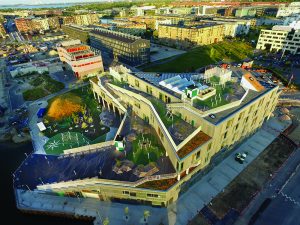Outdoor classrooms, an increasingly popular idea
Many teachers are calling for outdoor classrooms in different schools around the world. A good idea in times of coronavirus.
A desire to get some fresh air
In France, several teacher groups are demanding to teach outside of school. Following the general deconfinement, researchers and political personnel are increasingly supporting this idea.
Indeed, it is difficult for schools to enforce recommended health measures. Rooms are too small to allow for the social distance between students, for example.
Teaching in different ways
To hold a class outdoors is first to avoid promiscuity. Moreover, investing in parks, gardens, or seaside areas can boost children’s immune systems, rather than locking them in a room where the virus can easily spread.
But the green classroom also has educational benefits. Students, especially in the lower grades, develop their motor skills, since they can finally run, climb, explore. Above all, they are much more in contact with nature and their environment. Teachers can teach them about the colors, the weather, the flowers, or even the animals that the children encounter in their daily life.
The green classroom is also beneficial for teachers, who pay much more attention to their students and become more confident in their behavior. Less noisy and artificial spaces than a classroom reduce stress for both children and adults.
A study by The Wildlife Trusts has shown the benefits of green classrooms on learning. 79% of the children surveyed said they were more confident. Approximately 80% say they have a better relationship with their teachers and peers. There seems to be nothing but positive benefits from letting the class live outdoors.
Multiple and global initiatives
This is why several countries are gradually setting up off-site classrooms. In Austria, the parks remained open after confinement, mainly for children. Scotland has integrated outdoor learning into the official curriculum since 2010. British teachers are trained in outdoor classrooms. Several French and Italian schools are gradually moving out of their buildings. Quebec’s architects are imagining the school of tomorrow, drawing inspiration from experiences in Denmark.
In Austria, the parks remained open after confinement, mainly for children. Scotland has integrated outdoor learning into the official curriculum since 2010. British teachers are trained in outdoor classrooms. Several French and Italian schools are gradually moving out of their buildings. Quebec’s architects are imagining the school of tomorrow, drawing inspiration from experiences in Denmark.
Since the 1950s, Northern European countries have had classes in natural areas. Denmark is distinguished by a real desire to take advantage of an outdoor school. At the start of the 2020 school year, a lot of teaching takes place in the gym, in the courtyard, on the school parking lot, or in parks.
The school in the Sydhavnen district in Copenhagen was designed and built to allow children to benefit as much as possible from the benefits of nature. On the edge of a canal, the south-facing courtyard, a vegetable garden, a multitude of small parks, the school responds to the need to go outside the walls, felt by many after several months of confinement.
Sources: Guiding architects, Libération, The wildlife trusts, Basta
Photographs credits: Cheryl Holt/Pixabay; Ecole South Harbour, Copenhagen, JJW architects
Encourage us if you like positives stories!





